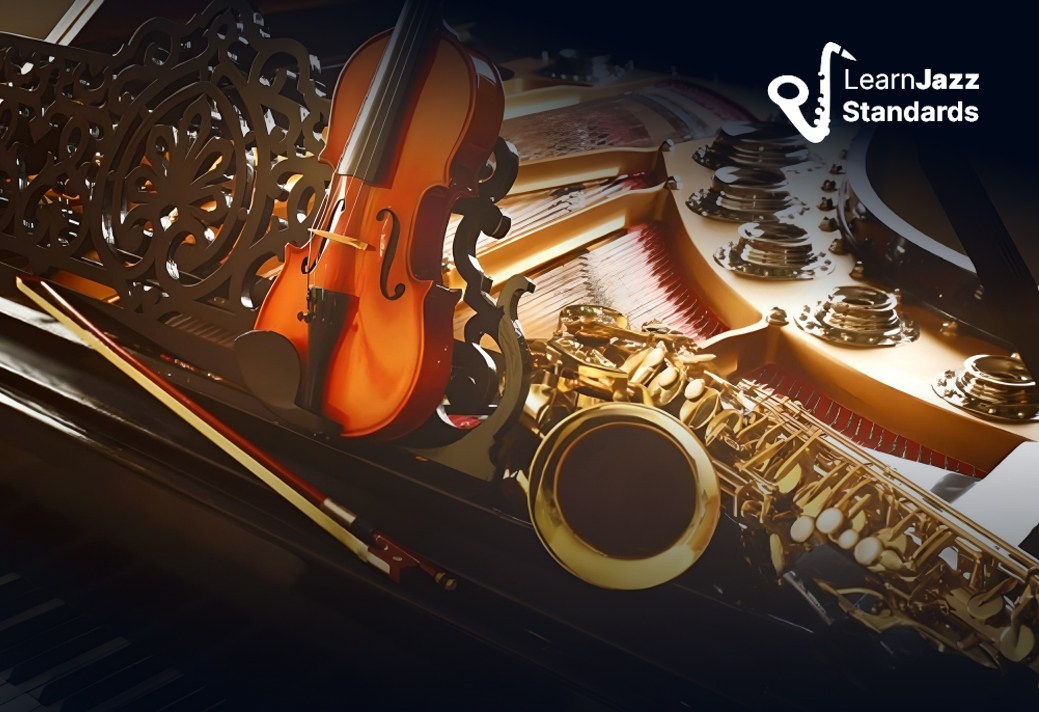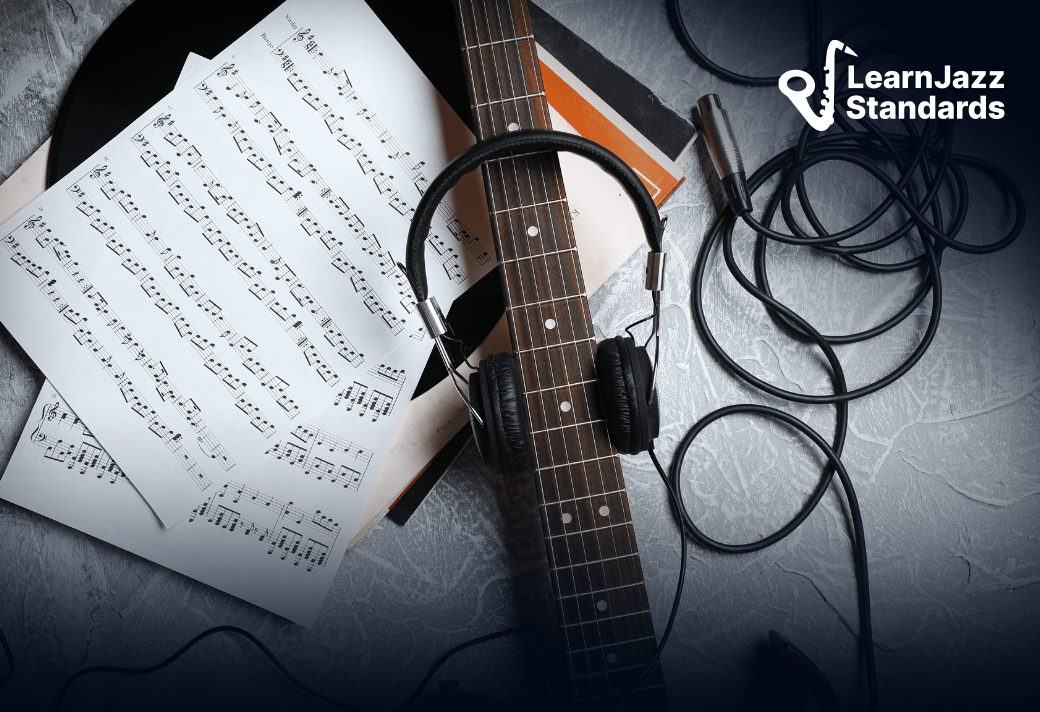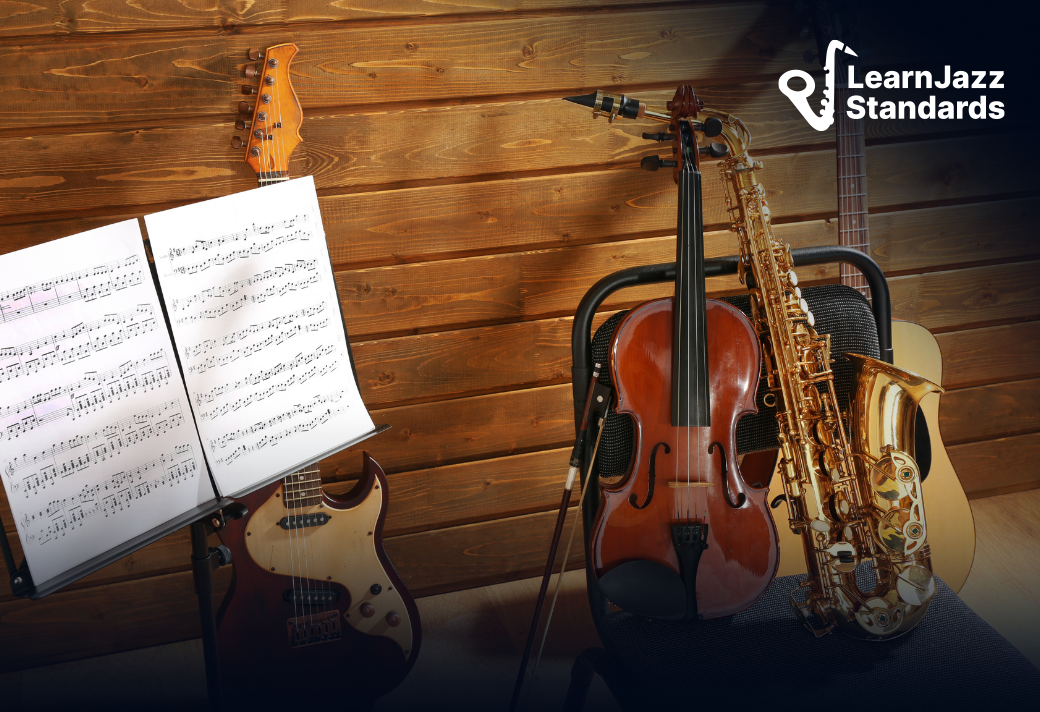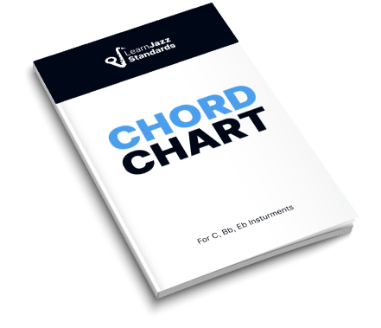Let me tell you one of the biggest myths I hear about learning how to play jazz:
You need to know a ton of music theory.
WRONG.
You don’t. You only need to know a little bit about music theory to get started with jazz improvisation, jazz harmony, and learning jazz standards. You’ll learn more naturally along the way.
In fact, when it comes to playing jazz, it’s more about learning the jazz language than theory.
With that being said, having a command of the basics of jazz theory—like jazz harmony and elements of the jazz language—will give you a massive advantage when playing jazz.
But here’s the problem: Most blogs, courses, Youtubers, and teachers make introduction to jazz theory way too hard.
They overcomplicate it with hundreds of different ideas on chord/scale theory, verbiage that leaves many musicians in the dark, and assumptions of knowledge that intimidate the beginner jazz student.
That’s where I come in.
I’m here to make learning jazz theory simple.
Here’s what I’ll cover in this guide:
Trust me when I say this is the only “jazz theory book” you need to play jazz, learn standard tunes, and crush it with jazz improvisation.
And, if you like what you read and want to join an active, passionate community of jazz musicians who are dedicated to improving their jazz playing, tune repertoire, and theory knowledge, then you need to check out the Learn Jazz Standards Inner Circle.
You’ll have everything you need to know to master jazz theory—
- You’ll gain access to over 100 courses designed to help you improve all aspects of jazz musicianship—from music theory and ear training to jazz tune analyses and improvisation workshops.
- You gain access to the real-world wisdom and knowledge of working jazz musicians who provide invaluable insight into the jazz mindset and best practices for shedding jazz and understanding jazz theory concepts.
- Improve the technical command of your instrument with our Instrument Accelerator Courses and learn how theory works on your instrument—now available for piano, trumpet, saxophone, bass, and jazz guitar.
Come see what the Inner Circle is all about!
Now, on with the post.
What Jazz Theory Is Useful For?

When musicians come to jazz and think that they need to learn a bunch of music theory to improvise, it is often under the assumption that jazz is a math equation needing to be solved.
Spoiler alert: it’s not.
Jazz music is, first and foremost, a language. It doesn’t matter what instrument you play, whether it’s jazz guitar, trumpet, drums, or voice. All instruments can speak the language of jazz.
Though all languages have rules—music theory is simply the grammar, sentence structure, and analysis element of understanding jazz language—you don’t need to know all the rules in to order a sandwich or have a conversation with someone.
Think about it:
Before you went to school and started learning the basic theory behind whatever your native language is, you were already speaking.
Learning grammar only helps you intellectually understand the language better and expand your abilities to express and formulate your own ideas.
That is what music theory does in relation to jazz music. You can spend all the money in the world on jazz theory books and never learn this basic fact.
What Is Jazz Theory Useful For?
Let’s first cover several great uses of music theory, which, as we mentioned earlier, are like the building blocks of jazz music.
1. It helps you understand what you are playing.
Have you ever learned a jazz lick from one of your favorite players, say Sonny Rollins and didn’t understand why it was so awesome?
Check this one out:

When you understand that he’s basically outlining the jazz harmony (a ii-V-I progression, in this case), the veil begins to lift. Here is what he does specifically:
- The ii: First, he outlines an F minor 9 arpeggio (G-F-C-Eb or 9th-1st-5th-7th)
- The V: Then he resolves to the 3rd of the dominant seventh chord (the D in Bb7alt) from a whole step below and a half step above, also emphasizing the b9 altered extension (the B♮)
- The I: Then, he resolves to the 3rd of the Eb7 (G)
Don’t be intimidated if everything I just said went over your head. That’s why we start with the basics!
Understanding chord progression is particularly important when trying to learn jazz standards. If you recognize what chord progressions you are dealing with, you can start simplifying things into categories rather than trying to remember individual chords.
2. It can help you conceptualize jazz language.
Jazz theory offers different ways to understand how to navigate chord changes.
This is especially apparent in what we call chord/scale theory, where we can match scales to chords. I’ll talk a lot more about this in the scales section.
Having this knowledge can also aid in composing your own music. If you understand the harmonic function of sounds, you’ll suddenly see a myriad of possibilities.
What is Jazz Theory Not Useful For?
While jazz theory is helpful for the reasons above, alone it will not be enough.
1. Learning jazz language
While jazz theory is helpful for understanding and conceptualizing jazz language, it’s not great for actually learning it.
As I alluded to before, when you first started speaking as a child you had no idea why and how language worked—it just worked.
You just heard your parents and family talk and copied them.
This is how we learn to improvise.
We listen, internalize, and then reproduce it our own way.
If you rely on theory or sheet music to learn jazz language, trust me, you will sound calculated and like you are running a bunch of linear scales. We don’t want that.
2. Improving your ear
When it comes to becoming a great improviser, improving your ear is one of the most important things you can do.
But music theory alone isn’t the best way to go about this.
You want to learn licks, solos, and standards by ear. You’ll also want to learn some of the fundamentals of ear training to be able to identify certain chords, certain scales, and important intervals.
Let’s start with step 1 of our “basic jazz harmony book.”
Step #1: Basic 7th Chords (The Building Blocks of Jazz Music)
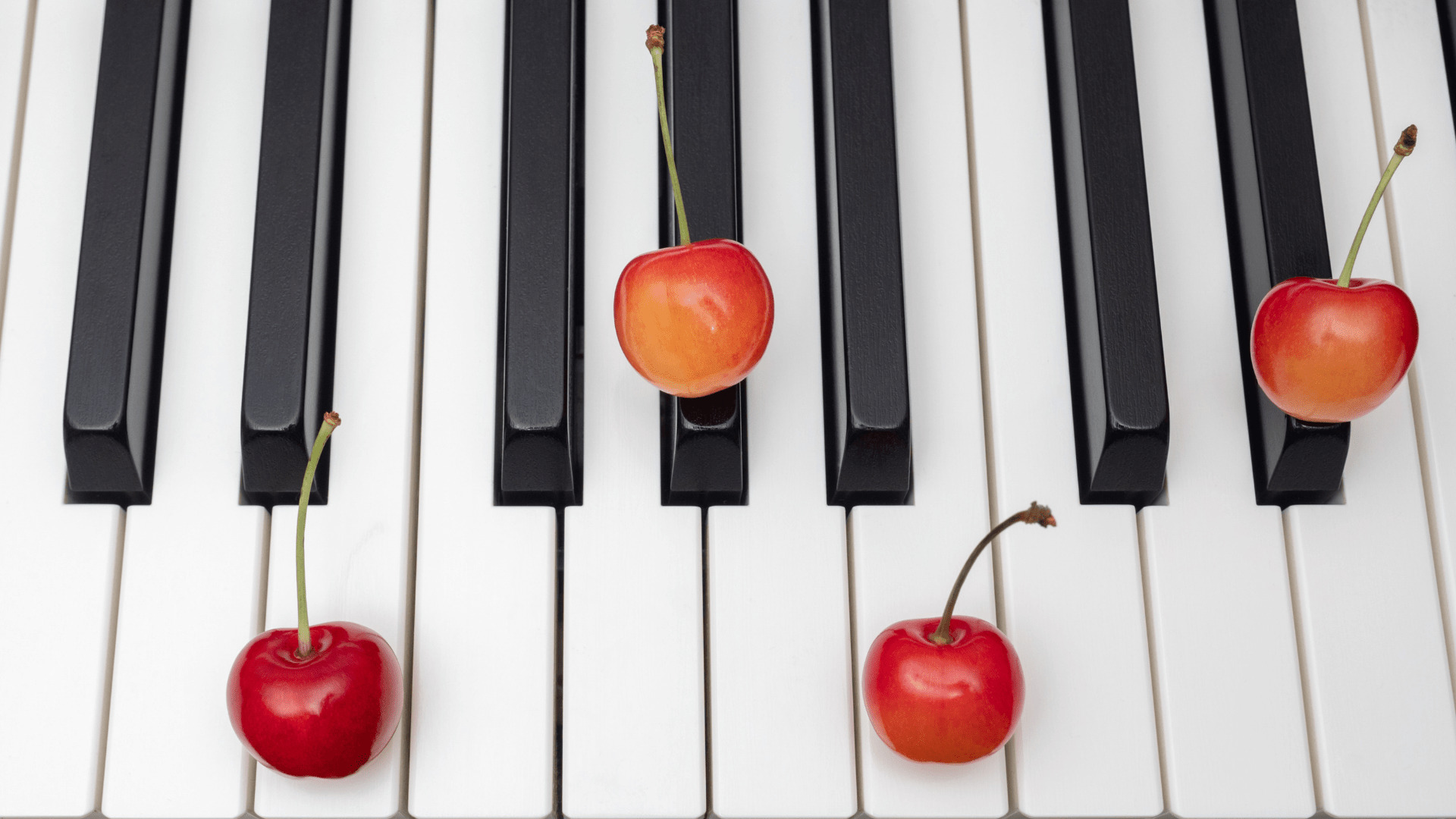
In my opinion, the first place to start with jazz theory is chords. If you understand chords, then you can start to learn jazz harmony. Specifically, regarding harmony, the ii-V-I progression is an essential part of how standard tunes are composed.
But we’re getting ahead of ourselves. To start, there are only five chords you need to know.
Notice I didn’t say scales. We’ll get to that later.
In particular, 7th chords are the basic chords used in jazz music.
Don’t get me wrong, triads are important. However, it’s the lush, colorful chords that give jazz a richer harmonic sound than other forms of music. If you were a painter, you’d want to use way more colors than just three. Chords that have more than three notes in them are called 7th chords because, in theory, after stacking a triad (root-third-fifth), the next note is the 7th.
What’s a 7th chord?
A 7th chord is a triad with the 7th tone of its corresponding scale stacked on top.
Basic formula: Root-3rd-5th-7th (3rd, 5th, or 7th altered depending on quality)
There are 5 qualities of 7th chords: major 7, dominant 7, minor 7, half-diminished, and diminished 7.
Let’s start with the major 7th.
Major 7 Chords
Formula for a major 7 chord: Root-3rd-5th-7th
Same as a major triad (Root-3rd-5th) but with the 7th scale degree stacked on top. Pretty simple, right? If you know your major scale (we’ll get to that), it’s simple to pick out where all of the chord tones come from.

When you stack these scale degrees on top of each other you get a Cmaj7: C-E-G-B.
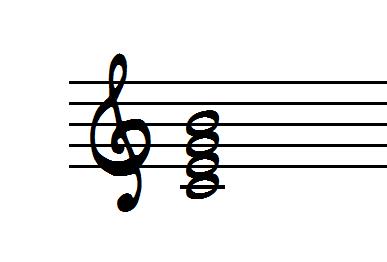
Of course, there are also inversions to all of the major 7 chord qualities. Because there are four chord tones, we end up having three inversions:
Here is the Cmaj7 notated in Root Position, 1st Inversion, 2nd Inversion, and 3rd Inversion.

Just to be extra clear, the 3rd Inversion has the 7th in the bass. If you see the 7th in the bass of a chord or arpeggio, it is in its 3rd Inversion.
Dominant 7 Chords
Formula for a dominant 7 chord: Root-3rd-5th-b7
Same as a major 7 chord but with a b7. Dominant 7 chords play a huge role in jazz and the blues, so these are important chords to have down solid! This chord comes straight out of the Mixolydian scale.

When you stack these scale degrees on top of each other you get a C7: C-E-G-Bb.

Here is the C7 notated in Root Position, 1st Inversion, 2nd Inversion, and 3rd Inversion.

Minor 7 Chords
Formula for a minor 7 chord: Root-b3-5th-b7
Like the minor triad, the 3rd is flatted. And like the dominant 7 chords, the 7th is flatted. Take a look at the natural minor scale, which is where you can draw these chord tones from.

When you stack these scale degrees on top of each other, you get a Cmin7: C-Eb-G-Bb.
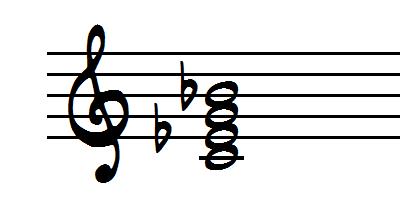
Here is the Cmin7 notated in Root Position, 1st Inversion, 2nd Inversion, and 3rd Inversion.

Half-Diminished Chords
Formula for a Half-Diminished chord: Root-b3-b5-b7
Take a minor 7 chord and flat the 5, and you have what we call a half-diminished chord. This chord is also commonly known as a minor 7(b5) chord. We can draw these chord tones from the Locrian scale.

When you stack these scale degrees on top of each other you get a Cmin7(b5): C-Eb-Gb-Bb.

Here is the Cmin7(b5) notated in Root Position, 1st Inversion, 2nd Inversion, and 3rd Inversion.

Diminished 7 Chords
Formula for a Diminished 7 chord: Root-b3-b5-bb7
That’s right! If you take a half-diminished chord and flat the 7th chord tone twice, you get a fully diminished 7 chord.
I suppose it makes the meaning of half-diminished all that more clear. We can draw these chord tones straight out of the Whole-Half Diminished scale.

Mind you, when we spell out the chord, we call it a bb7 not a 6, so in the key of C, it would be a Bbb.
When you stack these scale degrees on top of each other you get a Cdim7: C-Eb-Gb-Bbb.

That’s it!
If you know how to build these 5 qualities of 7th chords, you can play most jazz standards out there.
Chord Extensions and Alterations
Now, I would be doing you a bit of a disservice if I left it there and said there was nothing more to it.
Jazz musicians will often take these basic 7th chords and add more color to them.
What’s a chord extension?
Chord extensions are essentially chord tones that are added above the basic 7th chord structure (R-3rd-5th-7th).
The possible extensions are the 9th, 11th, and 13th. These extensions don’t replace the R-3rd-5th-7th but are added in addition to achieve the desired sound. However, in some cases, an extended chord may exclude a basic chord tone to avoid dissonance.
The easiest way to understand chord extensions is to think of them as the notes in between the basic structural chord tones: the 2nd, 4th, and 6th.
The 9th is the same as the 2nd, just up an octave.
The 11th is the same as the 4th, up an octave.
The 13th is the same as the 6th, up an octave.
If that doesn’t quite make sense right away, hopefully, this visual will help you see what I am talking about.

Which extensions can you use on 7th chords?
9th
You can add a 9th to: Major, dominant, minor, and half-diminished chords.
Formula: R-3rd-5th-7th-9th
Example: Cmaj9
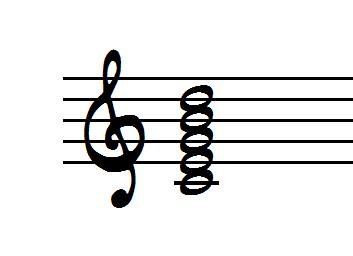
11th
You can add an 11th to: minor, half-diminished, diminished
Rule: the 11th can be added to chords with a b3 in it. Otherwise, the 11th would clash with the major 3rd.
Formula: R-3rd-5th-7th-9th-11th
Example: Cmin11
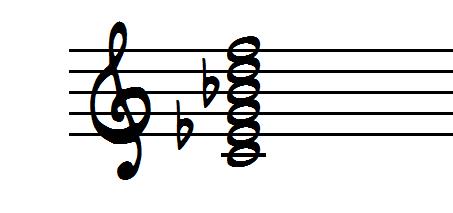
13th
You can add a 13th to: major, dominant, or minor.
Formula: R-3rd-5th-7th-9th-13th
Example: C13
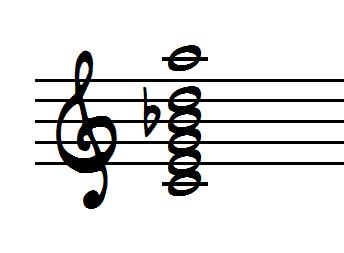
Note: 13th chords usually do not include the 11th in the chord.
What’s an altered extension?
Now, many of these extensions, depending on the chord quality, can be altered.
Major 7(#11)
Note: While the 11th is not used in a major 7 as an un-altered extension, it is used as an altered chord tone, specifically a #11.
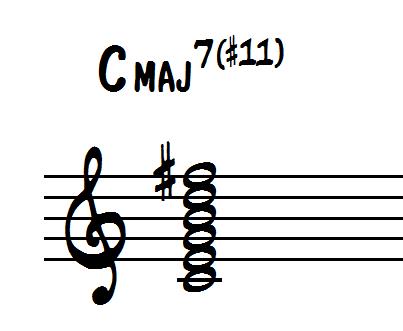
Dominant 7(alt)
Note: The dominant 7 chord has the most alterations possible. Also, the same as it was with the major 7, the 11th can be used with the dominant 7 as an alteration (#11).
One important chord to understand when it comes to dominant 7ths is the alt chord.
If you ever see on a piece of sheet music “C7alt” that just means that some or all of the extensions are included in the chord and altered.
Jazz musicians can choose to outline all of them, whether playing a chord or improvising or picking and choosing which ones are included.
Possible alterations for a dominant 7: b5, #5, b9, #9, #11, b13.
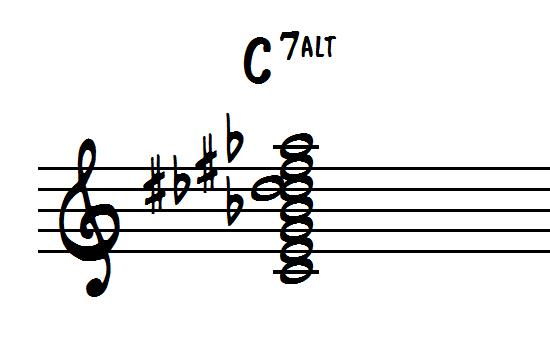
In summary:
- There are only 5 basic 7th chords we need to worry about in jazz
- Jazz musicians often add extensions and alterations to these chords to add more color
You don’t need to worry about knowing everything right away! The more that you learn jazz standards, the more you will face these chords.
But when we understand that the basic 5 7th chords are our cornerstone, we can breathe a sigh of relief and take a load off.
Step #2: Scales (aka. “Pitch Collections”)
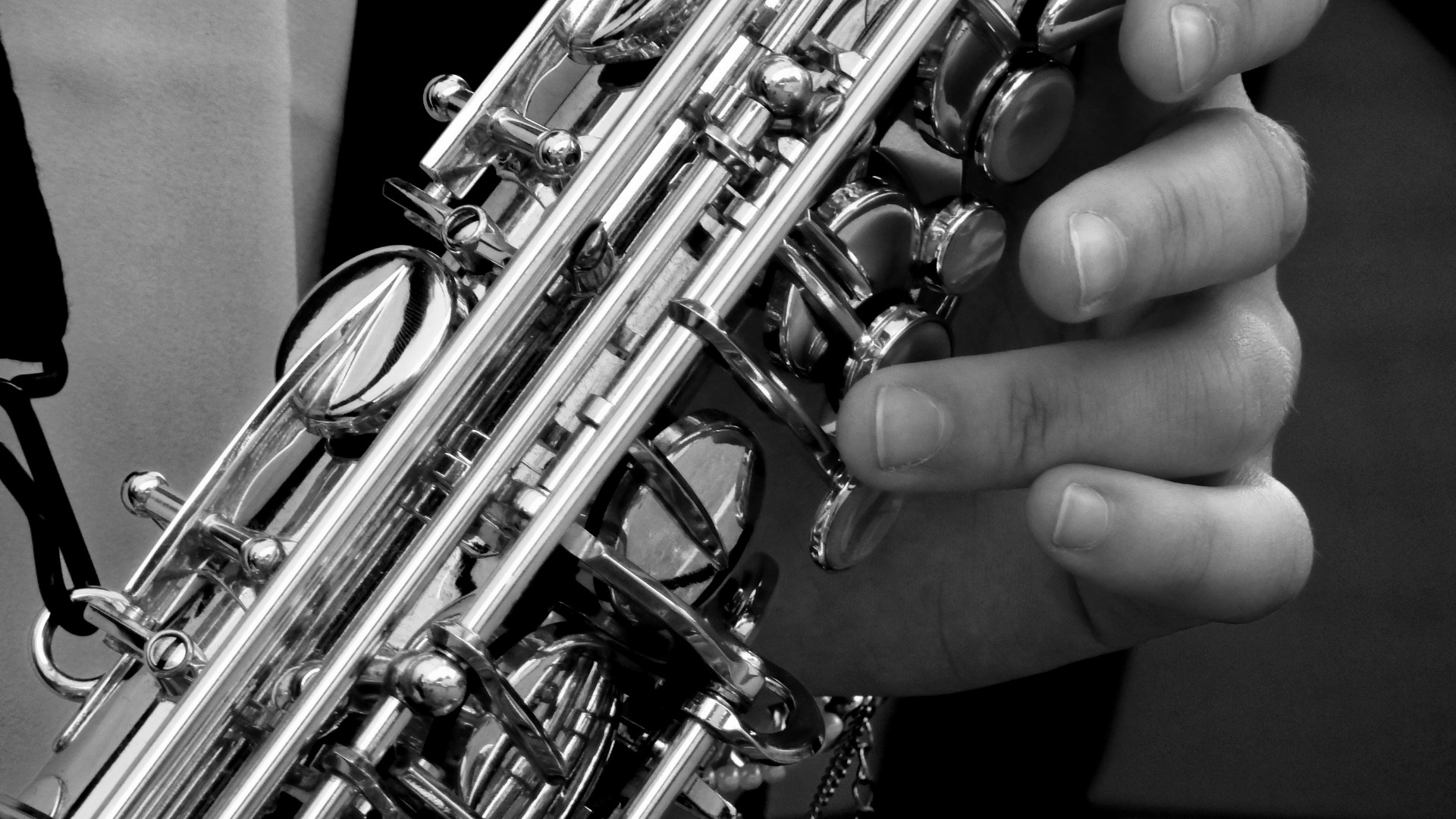
Prepare yourself for a rant!
So many musicians go straight to scales when starting to learn how to improvise over jazz standards.
It makes me want to curl up in a corner and start to weep.
Don’t get me wrong, scales aren’t bad. Quite the contrary!
But unfortunately, they are often misused.
Let’s start with some “pros and cons” of scales in general.
What scales are useful for:
1. Learning your instrument.
Scales are essential for learning how to navigate your instrument, understanding chord qualities, how to read music and other cornerstone elements of learning how to play. If you want to be a good jazz improviser, you need to know your instrument!
2. Technique.
Scales can help train you to move freely around your instrument without restrictions so that you can execute any musical situation you come across.
3. Conceptualizing musical ideas.
Scales can help you identify pitch collections that conceptualize a harmonic or melodic concept. Understanding different aspects of music theory can be incredibly helpful.
What scales are NOT useful for:
1. Learning jazz language.
To learn jazz language, you need to be listening to jazz music and learn solos and smaller musical phrases from the greats by ear.
Scales are pitch collections, not musical phrases. They will not help you learn the way jazz musicians speak and communicate with each other.
2. Learning how to play melodically.
A scale is not a melody. A scale is a set of musical notes ordered by fundamental frequency or pitch (there’s a bland textbook definition for you).
To play melodically, you need to learn melodies. Scales can show you what the “right notes” to play are, but they don’t teach you how to create actual music.
BEFORE YOU CONTINUE...
If music theory has always seemed confusing to you and you wish someone would make it feel simple, our free guide will help you unlock jazz theory secrets.

3. Improving your ear.
One of the most important things to be equipped with as a jazz musician is a great ear. To become an extraordinary improviser, you need to be developing your ear. Scales are calculated and, therefore, not great for training your ear.
Scales as “Pitch Collections”

If there is one thing I want you to take away from this section on scales, it is that scales should be thought of as “pitch collections.”
Pitch collections are simply an organized set of pitches that identifies note choices over a given chord or chord progression.
This is very different from thinking about them as scales, which insinuates playing a linear pattern.
When we think about scales this way, it is no longer “play a melodic minor scale over the minor i chord,” it’s. “Oh, look! I can target the major 7th in my line to add some color!”
That’s the difference.
If I can help you make that shift in your perspective, my job is well done.
The Only Scales You NEED to Know
This may make some people upset. But I’m not here to please everyone’s pre-conceived notions of jazz improvisation.
I’m here to make jazz easier.
The good news: I’ve already covered a handful of the scales when I talked about the chords. But there are a few new ones.
Here they are:
Major Scale
Intervallic formula: W-W-H-W-W-W-H
Scale tone formula: 1-2-3-4-5-6-7
C major scale: C-D-E-F-G-A-B
Chords you can play it over: any major 7 chords or any chord in the major diatonic series (I’ll talk about this in a second)

Dorian Scale (2nd mode of Major Scale)
Dorian is the 2nd mode of the major scale and starts on the second scale degree.
Modes don’t have to be confusing. Just think: If I have a starting note, what major scale is that the second scale degree of?
You can also think of this mode as a natural minor scale with a raised 6th.
Intervallic formula: W-H-W-W-W-H-W
Scale tone formula: 1-2-b3-4-5-6-b7
D Dorian: D-E-F-G-A-B-C
Chords you can play it over: Dmin7 (ii) or Dmin7 (i)

Mixolydian (5th mode of Major Scale)
Mixolydian is the 5th mode of the major scale and starts on the fifth scale degree. You can think of this mode as a major scale with a flatted 7th.
Intervallic formula: W-W-H-W-W-H-W
Scale tone formula: 1-2-3-4-5-6-b7
G Mixolydian: G-A-B-C-D-E-F
Chords you can play it over: G7 (V) or any dominant 7 chords.

Locrian (7th mode of Major Scale)
Locrian is the 7th and last mode of the major scale and starts on the seventh scale degree. The Locrian mode is a bit of a more obscure one. The best way to think of it is a major scale starting and ending on the leading tone (the preceding and last tone of the scale).
Intervallic formula: H-W-W-H-W-W-W
Scale tone formula: 1-b2-b3-4-b5-b6-b7
B Locrian: B-C-D-E-F-G-A
Chords you can play it over: Half diminished- aka. Minor 7(b5)

Note: You can also play what is called a Locrian #2 scale over a half-diminished chord. It’s spelled as it sounds. Just sharp the 2! Check out our blog post explaining musical modes.
Whole Half Diminished Scale
Diminished 7 chords show up in a variety of different circumstances in jazz.
Intervallic formula: W-H-W-H-W-H-W-H
Scale tone formula: 1-2-b3-4-#4-#5-6-7-8
C whole half diminished scale: C-D-Eb-F-Gb-G#-A-B
Chords you can play it over: Any diminished 7 chord

That’s it! Those cover all 5 qualities of 7th chords and are the most common options.
Please don’t get me wrong.
There are a lot more scales that you can apply over different kinds of chords, and if you’re looking for a slightly larger list that covers common chord alterations and such, check out this list of 16.
But since I fundamentally don’t believe we should rely too heavily on scales for jazz improvisation, I’m leaving it here.
In fact, I’ve even had the audacity to suggest you only need to know 2 scales for jazz improv (gasp)!
I won’t go into that further in this guide, but here is a video I did on the subject.
One important note:
I intentionally started with chords vs. scales because scales don’t necessarily spell out chord changes.
If you were paying attention, 4/5 of the chord qualities were essentially using the major scale, just starting on different scale degrees.
Chord tones are what matter.
The scales just represent notes you can play in between.
Step #3: Guide Tones and Voice Leading

When it comes down to it when improvising over jazz standards we want to hear the chord changes come out in our solos.
At least, that’s what I remember feeling when I first started out playing jazz. I would hear my favorite musicians play, and a big distinction between me and them was that I would be able to hear the chord changes even if there was no accompaniment.
So we’ve already identified the chord tones of the 5 basic 7th chords, and we’ve already figured out the notes in between (scales).
But we need to dig deeper and discover the notes that really make a difference.
That’s where guide tones and voice leading comes in.
What are guide tones?
Guide tones are notes within a chord structure that both help define a chord and can be used to transition to another chord melodically.
In jazz, the guide tones are the 3rds and 7ths.
These two notes are your best friends when it comes to jazz improvisation. Why?
Take a look again at the 7th chord formulas:
Major 7: Root-3rd-5th-7th
Dominant 7: Root-3rd-5th-b7
Minor 7: Root-b3-5th-b7
Half diminished: Root-b3-b5-b7
Diminished 7: Root-b3-b5-bb7
Now look through them and identify which notes are changing chord to chord.
It’s the 3rds and 7ths.
The only exception would be the b5 in the half-diminished and diminished 7, which would make the b5 a possible guide tone as well. But still, the 5th really isn’t the strongest of chord tones.
The 3rds and 7ths define whether a chord is major, minor, or dominant. In jazz harmony, this is incredibly important.
So do you think using the 3rds and 7ths in your musical lines is going to be important? You bet it is.
Let’s take a look at the 3rds and 7ths guide tones over a Cmaj7 to get started.
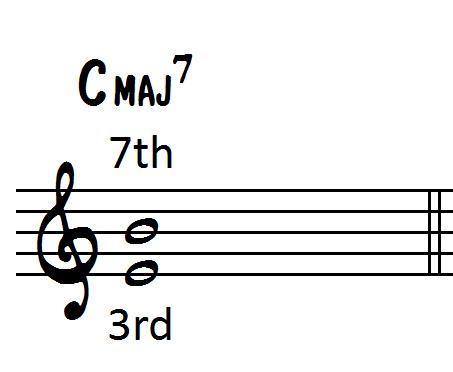
Now let’s take things up to the next level and introduce a ii-V-I chord progression (I’ll talk about those in a second—bear with me). We’ll stay in the key of C and use the chords Dmin7-G7-Cmaj7.

Dmin7 guide tones: F and C
G7 guide tones: F and B
Cmaj7 guide tones: E and B
Now I want you to pay close attention to something very important.
Did you notice how I started the Dmin7 with the 3rd in the bass, but then when we moved to the G7, the 7th was in the bass?
The reason I did this is to demonstrate good voice leading.
What is voice leading?
Voice leading is the smooth melodic movement of notes (or voices) from one chord to the next.
The reason I put the 7th of the G7 in the bass is because the F was already there. Also, see how the 7th of Dmin7 (C) moves in an easy stepwise motion into the 3rd of G7 (B)?
The key term there was stepwise motion.
Take a look at how these voices move.

Now let’s make these guide tones with voice leading melodic rather than chordal.

If you can start thinking about the guide tones and how you can target them in your lines, you WILL start to hear the chord changes come out in your solos.
There are many techniques and approaches for doing this, such as enclosure.
But having this basic knowledge will give you the tools you need to start to understand the music you are hearing and learning by ear.
Step #4: Jazz Chord Progressions

When it comes down to it, what do jazz musicians improvise over?
Chord progressions.
We already know the basic chords that are used in jazz standards, now it’s time to put the puzzle pieces together.
How to build chord progressions
I don’t want to leave anyone in the dark, so I will briefly explain a fundamental of music theory which is how to derive chord progressions.
In order to know how to build chord progressions, we need to start by harmonizing scales with 7th chords.
If we are in a major key, we will need to harmonize the major scale.

I’m skipping a few steps here, but essentially you start with a C major scale (key of C) and then stack 3rds on top of each scale degree.
When you do this, it automatically spells out different qualities of 7th chords.
Now, when we put this all together and add Roman numerals under each scale degree, we get what I call the “Major Diatonic Series of 7th Chords.”
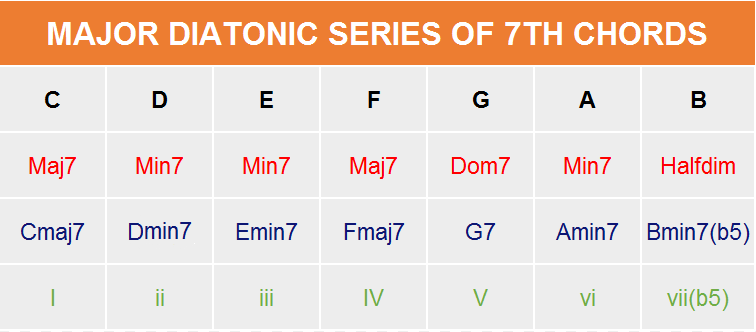
The Roman numerals are important, so keep this in mind when I discuss the basic jazz chord progressions in just one second.
Unfortunately, minor harmony isn’t quite so simple.
Why? Because there are 3 minor scales we can harmonize:
- Natural Minor
- Harmonic Minor
- Melodic Minor
Here they are harmonized:
Natural Minor Harmonized

Harmonic Minor Harmonized

Melodic Minor Harmonized

If you’re paying attention you can already see the problem.
There isn’t one set of possible changes!
For example, the natural minor has the V chord (Gmin7) as a minor 7 chord. In no world, universe, or alternate universe is a V chord ever anything but a dominant 7 chord.
At the end of the day, it’s about understanding the possibilities and then recognizing which combinations of harmonizations are most common.
Here is what I believe to be some of the most common:
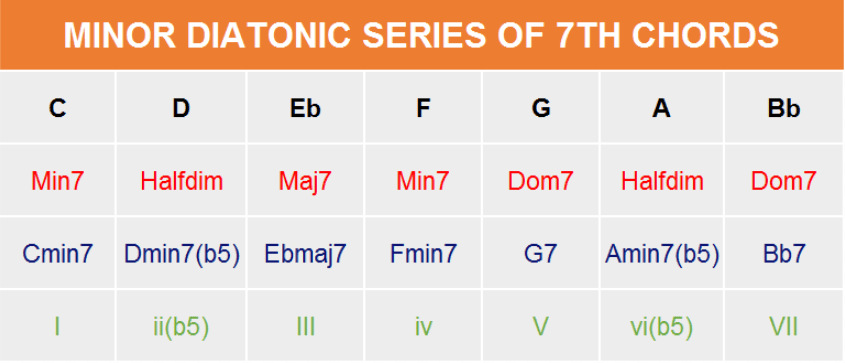
Note: Unlike the Major Diatonic Series, the top line does NOT represent a scale. It simply represents the root notes of each chord.
This being said, there are other chords that are used depending on the circumstance or the composition. This chart is just to help you have a basic understanding of what you commonly will see come up in jazz chord progressions.
For a more detailed explanation of minor harmony check out this video:
I also did a fantastic podcast interview with one of my old college professors on this subject:
4 Basic Jazz Chord Progressions
Once again, I’m going to boil things down and make this as simple as possible.
I’m going to show you the 4 most basic jazz chord progressions you will find come up time and time again in jazz standards.
1. Major ii-V-I
The major ii-V-I is easily the most important chord progression to get a handle on when it comes to jazz.
This chord progression is also important in other styles of music as well. You’ll want to spend plenty of time working on ii-V-I’s.
Example:

In this case, we are in the key of C major. Dmin7 is the ii chord, G7 is the V chord, and Cmaj7 is the I chord.
Refer back to the Major Diatonic Series chart to see where these come from!
2. Minor ii-V-i
This chord progression has the same function as the previous major ii-V-I, but of course, is in a minor key.
In many jazz standards, you will find major and minor ii-V-I’s in the song form.
Example:

The V chord can be altered, meaning you can add a b9, #9, or #5 (sometimes #11). In this case, I notated the V as just a regular G7 chord, but know that jazz musicians will often manipulate this.
3. Major I-vi-ii-V
This chord progression you see all of the time. You can find it most naturally in any rhythm changes tune, such as Oleo.
Example:

It’s important to note that the vi chord, to be diatonically correct, is a minor chord. However, jazz musicians will often turn it into a dominant 7 chord.
This is common practice, and so I have listed it as an option above. This is important to be aware of.
4. Minor i-vi-ii-V
Now let’s bring this progression into the minor.
Example:

Remember that the vi chord in the minor diatonic series is being borrowed from the melodic minor harmonization of 7th chords. Therefore it is a half-diminished chord.
These are the basic 4 jazz chord progressions.
Please don’t get me wrong. There are plenty of other chord progressions and alterations that come up in jazz standards, but if you know these, you will have a solid foundation.
If you want a slightly larger list with some other possibilities, check out my 9 Jazz Chord Progressions You Need to Master post.
So how do I start improvising over chord progressions?
Given what we’ve learned in this guide, here are some options:
- Learn licks by ear over these important chord progressions that you find on recordings.
- Map out the chord tones and connect them together with voice leading.
- Map out the guide tones and connect them together with voice leading.
- Map out the scales and connect them together with voice leading.
This is where we come full circle to what jazz theory is good for and not good for.
First and foremost, you need to learn jazz language, which is best done by learning it by ear.
However, armed with this jazz theory knowledge, you now have the ability to understand the sentence structures and understand how jazz standards are constructed.
Next Steps for Jazz Improv Success

The heart of my message in this Ultimate Guide to Jazz Theory has been this:
Jazz theory can be made simple.
I’ve given you the essentials, and you don’t need to know much more in order to start succeeding as a jazz musician. I strongly believe that.
However, if you want to go beyond the basics and take your jazz playing to the next level, then check out the Learn Jazz Standards Inner Circle.
When you join the Inner Circle, you get access to everything you need to accelerate your jazz playing and exponentially expand your jazz theory knowledge, including access to:
- Monthly jazz standard studies to help you understand jazz theory in practice and improvise over jazz standards
- In-depth courses and practice programs to help you target and fill the holes in your playing and theory knowledge
- Plus, you’ll join a diverse community of musicians who love jazz as much as you do
Ready to accelerate your jazz playing and understanding of jazz theory? Come see what we’re all about.


